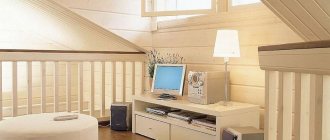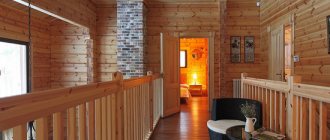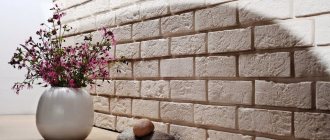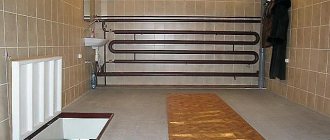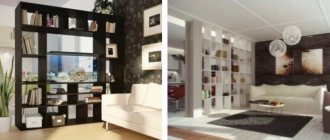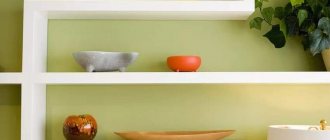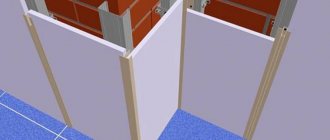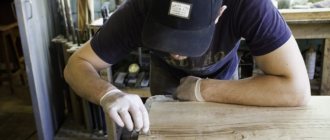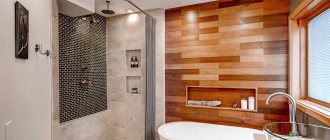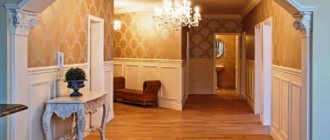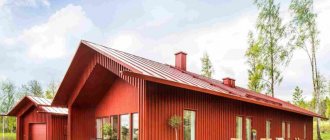The kitchen walls can be decorated in any style and direction. Materials such as MDF panels for kitchens are in demand and popular due to their practicality and aesthetic appearance. Walls above the sink level and surfaces are always subject to contamination and splashes of grease. To successfully resolve this issue, you need to select the optimal design option for the kitchen apron.
Decorative panels based on MDF are budget finishing materials
Kitchen design with MDF panels (photo selection)
Modern material is made in different styles and with different textures. Some of the most popular ones are laminated or veneered models, which are made to look like natural wood: pine, alder, mahogany, maple. The surface can be any - glossy or matte, optionally decorated with an image (photo printing or 3D effect).
In the interior of the kitchen, MDF panels can be used for full or partial cladding of walls, ceilings and other surfaces
Panels made “to look like stone” are not inferior. The material comes in different interpretations; there are even models made to look like metal or glass. The “openwork” sheets look beautiful and neat. If desired, they can be combined with any finish. Using MDF panels for the kitchen is beneficial, as it is not only practical, but also very beautiful. Natural wood can crack from moisture and steam; this cannot happen on artificially created smooth panels.
Installing the apron yourself
Although the process of installing a kitchen backsplash is quite simple, there are several problems that a novice worker may encounter. First of all, you need to decide on the placement of the facing covering and the method of its fastening. Everything else depends on the type of kitchen apron itself.
Working with sheet plastic
When installing a plastic apron, you need to decide in which direction the panels will be located. If the plastic sheet is wide enough, it is better to place it horizontally so that there are fewer seams on the apron. Narrow panels should be cut into pieces and mounted vertically.
The plastic cladding is attached to the wall using liquid nails. For greater reliability, self-tapping screws are screwed into the edges of the apron. Sharp sections of plastic are covered with decorative skirting boards or starting strips. The joints should be masked with strips of a suitable color.
Using chipboard
Chipboard (chipboard) is a material that is often used to cover the walls of the kitchen work area. The chipboard apron is mounted only on a flat surface using glue. Before installation, the slab is cut into pieces of the required size. Large and heavy chipboard sheets should be additionally secured using self-tapping screws with decorative caps.
Application of ceramic and mosaic tiles
When covering the walls in the kitchen with ceramic tiles or mosaics, you must first prepare a special adhesive solution. The mixture is applied to the wall with a narrow spatula and distributed evenly over its surface. The tiles are installed with slight pressure.
The tiles are laid evenly and neatly in horizontal rows from bottom to top. When attaching each row, check the horizontal position using a level. The mosaic should not be laid individually, but in matrices. Each forms a slab measuring 30x30 cm, containing several dozen elements. Otherwise, installation is similar to tiles.
Glass requires care
Glass splashbacks are mounted to the wall using supporting clamps or adhesive. The supporting fasteners prevent the glass from fitting tightly to the countertop and cabinets. A gap forms between the wall and the glass panel. The advantage of this type of fastening is that it does not require drilling holes in the glass that compromise the strength of the structure.
The maximum load on a pair of fastenings should not exceed 10 kg. 1 m² of glass with a thickness of 1 mm weighs 2.5 kg.
Installation with glue is only possible if the glass apron is made of triplex. Since glue is a chemically active substance, it will most likely corrode any simple glass over time. To attach glass panels made of artistic triplex, glue-sealant for mirrors is used.
Stone apron originality and practicality
An apron made of monolithic artificial stone is pre-cut to the required dimensions. Its installation should include fastening not only with an adhesive solution, but also with anchor connections. To screw them in, you need to make holes in the wall about 10 cm deep. This will allow you to securely fasten the massive structure.
Using an uneven spatula, apply an adhesive solution to the back surface of the slab. With a gentle tap of the mallet, the apron is pressed against the wall. After this, anchoring begins.
The anchors take their place and are carefully twisted. Do not over-tighten the fasteners as this may damage the structure of the stone slab. After tightening the anchors, the holes in the slab can be closed using special pads.
MDF material - what is it?
What does MDF mean? The abbreviation is translated as “fine fraction”. The manufacturing process uses wood fibers with average densities. They are pressed together under high pressure and temperatures. To make the panels stronger, the composition contains a binding component - resin. The production produces standard models, but you can get the required sizes for an individual order.
Wall panels are sold ready-to-install and can be painted, laminated or veneered
There are certain GOSTs, according to which MDF passes as an environmentally friendly raw material, ahead of many types of wood.
Advantages and disadvantages of MDF as a finishing material
MDF panels for the kitchen have the following advantages:
- no need to pre-prepare the surface for installation;
- the finish is perfectly polished and does not crumble;
- environmentally friendly material, does not harm human health;
- it is quickly and easily cleaned from dirt and dust, and there is no debris or waste during installation;
- good price-quality ratio, accessibility for everyone who wants to make repairs;
- finishing can be done on your own, without the involvement of craftsmen.
MDF panels are available in a huge range of design solutions - you can choose an imitation of stone or wood, or choose a material to match the tabletop
There are also disadvantages:
- the panels are not friendly with moisture in large quantities and negatively perceive temperature changes;
- if you do not cover the material on top with a special fire-prevention device, there is a risk of fire;
- MDF sheets of small thickness can be easily damaged as a result of transportation or mechanical stress.
Such panels are equally suitable for finishing walls and ceilings, and their installation does not require careful leveling of surfaces
How to choose
Before choosing panels, you should pay attention to several parameters: type, thickness, shape and texture.
Classification of panels by shape and size:
- Reiki . These are rectangular planks with a “lock” fastening along the long sidewall. Used for walls and ceilings.
- Long and wide lining . It is used, as a rule, to decorate the walls of large rooms.
- Square and rectangular slabs . Selected according to customer sizes. Typically large in size to handle as few seams as possible.
The thickness of the panel also matters when choosing and depends on the future method of application . Plates with a thickness of 5 to 9 mm are used, as a rule, for finishing the ceiling, because they have less weight and low strength. Panels of medium thickness - from 10 to 18 mm - are strong and can be used for wall decoration and furniture finishing. For additional thermal insulation and sound insulation, slabs up to 38 mm thick are used.
In addition to shape and size, MDF allows you to experiment with the texture of the future wall . Smooth and glossy panels visually expand the space and, when choosing light shades, give an additional feeling of illumination. But dirt and scratches are more noticeable on them. Plates with texture look very realistic and impressive; cuts are less visible on them, but at the same time they are not so easy to care for.
Choosing a design
Kitchen panels made from high-quality MDF are distinguished by a large assortment and different designs. You can buy something for every taste: ash, wood shavings, imitation stone, brick. Focus on a well-known manufacturer: this will always help you choose good material.
Wall panels must be selected taking into account the design of the kitchen in general and the furniture in particular - you can focus on the color and texture of facades, countertops, flooring or curtains
Before choosing a separate option, let’s consider the type of coatings with which the slabs are produced:
- laminate;
- paper;
- veneering;
- surfaces that repel water.
It’s worth choosing according to your design and type of room. A water-repellent, fire-resistant coating is ideal for the kitchen.
Interesting solutions in the interior design of a private house and apartment (photo selection)
Thanks to the large assortment, you can beautifully decorate any room, and the variety of textures helps to create truly stylish compositions. Textures like wood or natural stone look impressive. When selecting MDF sheets, consider the functionality of the space and zoning. If the kitchen is made in a classic style, you can focus on brightness and add creativity. A combination of light and dark shades looks good.
A successful combination of a solid wood tabletop and a section of wall in the dining area with wood paneling
In a kitchen combined with a dining room, you can combine the paneling - decorate the lower part in a dark color, add pastel on top or... You can use a wooden plank to emphasize the contrast. Striped trim visually expands the space. A good option is laminated panels imitating natural wood or stone. Veneer boards are similar in structure to wood - they look impressive and beautiful.
Classic solution for kitchen interior - dark bottom and light top
Using MDF panels you can create a unique and extraordinary interior
MDF boards have good qualities compared to ceramic tiles - they are easy to clean and look much more impressive and more expensive. If you choose several shade options, you can zone the space in an interesting way, highlighting the dining and cooking area. Partitions with wall panels look good. Here you should prefer veneered or varnished surfaces. Kitchens made from MDF panels with photo printing, photos of which can be viewed on the Internet for inspiration, look very original.
Decor with wood panels on the walls in the kitchen dining area
Installation of MDF panels on the wall
Having decided on the shape of the material, preferences regarding color and photo or pattern, you can begin installing the panels in the kitchen.
- First of all, you should treat the walls with antiseptic agents, because you will not be able to monitor their surface when you cover it with panels. This is especially important for arranging a screen made of MDF instead of skins or tiles, because this is where contact with water and elevated temperatures occurs more often. In addition, condensation may accumulate behind such finishing.
- In order not to level the surface of the walls, it is better to use lathing to fasten the panels. For this you will need wooden slats. Metal guides, on which drywall is usually attached, are not suitable in the case of arranging a screen instead of a skinnel, since the width of such profiles will significantly extend the wall above the desktop. This is acceptable if the entire wall behind the work set is finished with MDF panels. The photo shows the installation of the first panel
- Prepare dowels and screws. Perhaps a staple gun is more suitable for attaching the panel to the sheathing. You will also need a screwdriver and tools to determine the vertical and horizontal.
- You need to start installation from the most protruding section of the wall if its surface is uneven and has differences. The assembly of the entire finish occurs very quickly: it is enough to fasten the first panel, the rest are connected to it by a groove system.
We consistently fix our cladding - When you need to attach a strip that will contain sockets , you should first mark their location, cut it out, and then install the panel. Some craftsmen begin installation with exactly those parts into which sockets need to be embedded, but on one wall there may be several of them in different places, so this approach is not always advisable.
- Having finished installing the cladding, you should close the edges of the panels : if we are talking about the walls of the dining area, traditional plinths and ceiling fillets are used here. The surface of the apron is connected to the desktop, usually using a corner of a suitable color. It is not necessary to cover the top of such a screen with a corner in connection with the upper cabinets, but to a certain extent it will protect against excessive penetration of steam and grease behind the furniture.
By spending a little time and effort, you will get an environmentally friendly, comfortable and, of course, beautiful kitchen.
How to choose a good MDF panel
The material is relatively inexpensive, but it is important to pay attention to quality. How to understand what material is considered good:
- There must be quality certification - you have every right to ask to see the document during the selection process. If it is present, it means that the material does not contain harmful components (resins and formaldehyde).
- There cannot be many defective elements in a batch - this indicates low quality.
- The colors of the products must be the same, and the coating must be uniform.
Well-known manufacturers, as a rule, value their reputations and produce high-quality products. It’s better to overpay for a brand than to run into a material that will wear out after a while and begin to smell of formaldehyde
MDF boards are distinguished by good characteristics, naturalness and safety. This is a good option for finishing a kitchen surface, which is not only of high quality, but also very attractive in appearance.
Types of kitchen aprons - their advantages and disadvantages
To create an apron, you can use a variety of materials from ordinary tiles to stainless steel and natural stone.
Ceramic tile
Tile is a practical, dense material with a low-porosity structure and protection in the form of a top layer of glaze. Does not react to temperature changes, does not absorb moisture and detergents, is durable, decorative, and can serve faithfully for many years. The market offers a huge number of variations of this material of various shapes, with various textures, colors and prints. These qualities make it a sought-after and popular option for finishing the kitchen apron area. The only weak point of the tile covering is the seams, which must be regularly cleaned and treated with antibacterial agents. Another disadvantage of this type of finish is the difficulty of doing it yourself.
Ceramic tiles should not be used to cover a wall in a wooden house. These two materials have different coefficients of moisture absorption and thermal conductivity, which can cause the destruction of the finish.
Glass apron
Glass is just as practical as ceramics, and its popularity has gone through the roof lately. The ability to create a seamless apron makes it possible to significantly simplify the installation of the skinal - the so-called sheets made of tempered glass - and make it easier to care for the coating.
Glass aprons cope well with moisture and dirt. They are easy to wash using special detergents and cleaning products. They are characterized by excellent:
- hygiene;
- fire resistance;
- decorative - when decorating them, they use engraving, painting, tinting, matting, and photo printing.
The surface of the skin can be glossy, matte, smooth or embossed. Photo printing makes it possible to apply any images, which allows you to create unique interiors. Approximately the same effect can be achieved by gluing images on the wall under transparent glass. The advantage of this method is that you can change the design at any time with minimal investment - bright pictures often get boring quickly. In addition, this will allow you to save a lot of money - photo printing is an expensive pleasure.
It is believed that glass is inferior to ceramics in strength. In fact, it is very difficult to break tempered glass or triplex. But if this does happen, there will be no threat to your safety - fragments of triple glazing will remain on the film, and fragments of tempered glass will not hurt you, since they do not have sharp edges.
The only drawback of the material is that any drops, stains and spots on the glass surface are very noticeable.
Plastic apron
An apron made of acrylic, PVC, polycarbonate is an affordable, attractive option. However, it is much inferior in durability to previous materials. Plastic surfaces perfectly protect walls from splashes of grease and water, but are very sensitive to high temperatures and cleaning agents.
You should not install a plastic panel in the apron area near the gas stove. When purchasing, pay attention to the coefficient of thermal expansion - it should have a minimum value. This is the main condition in order to avoid destruction of the panel due to temperature changes.
The following types of plastic are suitable for wall decoration:
- ABS - polymer resin is used to make panels. The result is a plastic material that can withstand certain mechanical stress. It tolerates moisture and high temperatures well. However, it should be remembered that heating should not exceed 80 degrees. There is no need to worry about material damage due to contact with detergents. He is not afraid even of chemicals that contain acid. You can apply a design to an ABS apron that will not fade over time, provided there is no constant and targeted exposure to ultraviolet radiation. Installing and dismantling an apron made of such material will not cause any difficulties, but the base must be as level as possible, otherwise “humps” will form on the panel;
- PVC is the most affordable type of panels for aprons. The cost per square meter ranges from 160-180 rubles. The material is presented in the form of slats and sheets. PVC aprons are decorated using offset printing. A top layer of varnish protects the image. You can choose an option that imitates brickwork, wood or natural stone. To clean the panels, you can use any cleaning agents, including abrasives. It is quite difficult to remove dirt from seams, so fungus may form in them. The material is afraid of shocks and high temperatures - it deforms when heated. This material cannot boast of durability.
The panels are easily mounted with liquid nails and hide minor imperfections in the base. Installation can be easily done by yourself.
- polycarbonate – has a smooth surface, making it easy to clean. Another advantage is resistance to high temperatures and the absence of toxic emissions during heating. It is not difficult to build an apron from this material. The panels are very easy to cut and install with glue. If the walls are not level enough, you can secure the plastic sheets with self-tapping screws. The colors do not lose their brightness even when exposed to sunlight.
Natural and artificial stone
The advantage of natural and artificial stone is its decorativeness and strength characteristics. However, not every material is suitable for creating a kitchen apron. For example, natural marble requires regular polishing, which is not very convenient for vertical surfaces. In addition, such a coating quickly absorbs dyes and dirt, which cannot be cleaned.
Acrylic stone is an excellent option for an apron. It does not absorb moisture, is resistant to heat, and can be easily restored. It is optimal when the apron made of this material is a continuation of the cast countertop. In this case, there is no joint between the work surface and the wall, which contributes to the hygiene and durability of the kitchen set.
Quartz agglomerate is a more expensive option due to the high content of natural stone chips in its structure. The material is externally indistinguishable from natural granite or marble, is highly resistant to moisture and high temperatures, and is easy to clean with detergents. The seamless monolithic surface, devoid of pores, looks very presentable. Artificial stone is available in a wide variety of colors; options with a mirror or relief surface are possible. Long years of service do not affect the color saturation. The material is not subject to deformation or destruction and does not require restoration. Agglomerate is relatively affordable compared to natural stone.
Stone cladding is not suitable for a wooden house.
Chipboard apron
Among the materials that can provide reliable protection for kitchen walls, we can highlight chipboards - chipboards. They are made from a mixture of sawdust and a special adhesive mass using the pressing method. Typically, products consist of three differently directed layers of chips, which allows them to provide sufficient rigidity. The products have many positive properties necessary for high-quality wall protection in the work area. They are environmentally friendly, since the proportion of formaldehyde present in them, which is hazardous to health, is strictly limited.
MDF apron
MDF boards are slightly inferior to glass and ceramics in terms of durability and resistance to mechanical stress. The advantages of this material include the ability to withstand temperature changes and exposure to moisture. It is much more affordable compared to skinali, but is absolutely not inferior to them in terms of decorativeness. The panels can be matte or glossy, decorated with paintings, photo printing, with all sorts of color effects - for example, “chameleon”. This finish is optimal for a wooden house - after all, the properties of MDF boards are not much different from the properties of natural wood. The panels are convenient to mount directly on the wall. The panels can be covered with acrylic or film. The former are much more resistant to steam, dampness, and temperature. The latter are best used in a kitchen with an induction or electric stove.
Metal
Stainless steel is a very popular material, which is quite often used as a material for an apron. Not everyone will like this design, but if we talk about other indicators, then it simply has no rivals. Steel is extremely durable, absolutely waterproof, fire-resistant, and insensitive to household chemicals - not excluding abrasives. A metal apron is an excellent accessory for a kitchen in a high-tech or loft style. It gives a certain coldness to the interior, which is relevant for these areas. The only trouble is that dried drops and stains are very noticeable on the metal surface. It looks quite repulsive, but if the hostess is philosophical about this circumstance or does not mind constantly wiping the surface, then there is nothing wrong with it.
